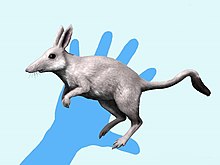Polydolopimorphia
| Polydolopimorphia Temporal range:
| |
|---|---|

| |
| Argyrolaguspalmeri | |
| Scientific classification | |
| Domain: | Eukaryota |
| Kingdom: | Animalia |
| Phylum: | Chordata |
| Class: | Mammalia |
| Clade: | Metatheria |
| Clade: | Marsupialiformes |
| Order: | †Polydolopimorphia Archer, 1984 |
| Subgroups | |
Polydolopimorphiais an extinct order ofmetatherians,closely related to extantmarsupials.Known from thePaleocene-PlioceneofSouth Americaand theEoceneofAntarctica,they were a diverse group during the Paleogene, filling many niches, before declining and becoming extinct at the end of theNeogene.[1]It is divided into two suborders, Bonapartheriiformes, and Polydolopiformes[2]Most members are only known from jaw fragments, which have their characteristically generallybunodontteeth.[3]The morphology of their teeth has led to proposals that polydolopimorphians may be crown group marsupials, nested withinAustralidelphia,[4]though this proposal, has been questioned, with other analyses finding them outside of crown-group Marsupialia.[3]Themonophylyof the group has been questioned, due to the possibility of the characteristic bunodont teeth emergingconvergentlyin unrelated groups, rather than reflecting a truephylogeneticrelationship.[5]The group containedomnivorous,frugivorousandherbivorousforms.[4]
Taxonomy
[edit]Taxonomical subdivision of the Polydolopimorphia:[6]
- Suborder Bonapartheriiformes
- FamilyBonapartheriidaePascual 1980
- GenusBonapartheriumPascual 1980
- GenusEpidolopsPaula Couto 1952
- FamilyArgyrolagidaeAmeghino1904
- GenusAnargyrolagusCarlini et al. 2007
- GenusArgyrolagusAmeghino 1904
- GenusHondalagusVillarroel & Marshall 1988
- GenusKlohniaFlynn & Wyss 1999
- GenusMicrotragulusAmeghino 1904
- GenusProargyrolagusWolff 1984
- SubfamilyChulpasiinaeSigé et al. 2009
- GenusChulpasiaCrochet & Sigé 1993
- GenusThylacotingaArcher et al. 1993
- FamilyPrepidolopidaePascual 1980
- GenusIncadolopsGoin & Candela 2004
- GenusPerrodelphysGoin et al. 1999
- GenusPunadolopsGoin et al. 1998
- FamilyRosendolopidaeGoin et al. 2010
- GenusHondonadiaGoin & Candela 1998
- GenusRosendolopsGoin & Candela 1996
- FamilyBonapartheriidaePascual 1980
- Suborder Polydolopiformes
- Family PolydolopidaeAmeghino 1897[7]
- GenusAmphidolopsAmeghino 1902
- GenusAntarctodolopsWoodburne & Zinsmeister 1984
- GenusArchaeodolopsAmeghino 1903
- GenusHypodolopsChornogubsky 2020
- GenusKramadolopsGoin et al. 2010
- GenusPliodolopsAmeghino 1902
- GenusPolydolopsAmeghino 1897
- GenusPseudolopsAmeghino 1902
- FamilySillustaniidaeCrochet & Sigé 1996
- GenusSillustaniaCrochet & Sigé 1996
- GenusRoberthoffstetteriaMarshall et al. 1983
- Family PolydolopidaeAmeghino 1897[7]
- incertae sedis
- GenusPrepidolopsPascual 1980
- GenusWamradolopsGoin & Candela 2004
- GenusBobbschaefferiaPaula Couto 1970
References
[edit]- ^Beck, Robin M. D. (2016)."The Skull of Epidolops ameghinoi from the Early Eocene Itaboraí Fauna, Southeastern Brazil, and the Affinities of the Extinct Marsupialiform Order Polydolopimorphia".Journal of Mammalian Evolution.24(4): 373–414.doi:10.1007/s10914-016-9357-6.ISSN1064-7554.PMC5684316.PMID29187780.
- ^Chornogubsky, Laura; Goin, Francisco J. (2015). "A review of the molar morphology and phylogenetic affinities of Sillustania quechuense(Metatheria, Polydolopimorphia, Sillustaniidae), from the early Paleogene of Laguna Umayo, southeastern Peru".Journal of Vertebrate Paleontology.35(6): e983238.doi:10.1080/02724634.2015.983238.hdl:11336/46844.ISSN0272-4634.S2CID86106580.
- ^abBeck, Robin M. D. (2023), Cáceres, Nilton C.; Dickman, Christopher R. (eds.),"Diversity and Phylogeny of Marsupials and Their Stem Relatives (Metatheria)",American and Australasian Marsupials,Cham: Springer International Publishing, pp. 1–66,doi:10.1007/978-3-030-88800-8_35-1,ISBN978-3-030-88800-8,retrieved2023-05-14
- ^abGoin, Francisco J.; Woodburne, Michael O.; Zimicz, Ana Natalia; Martin, Gabriel M.; Chornogubsky, Laura (2016),"Phylogeny and Diversity of South American Metatherians",A Brief History of South American Metatherians,Dordrecht: Springer Netherlands, pp. 155–183,doi:10.1007/978-94-017-7420-8_5,ISBN978-94-017-7418-5,retrieved2022-02-19
- ^Beck, Robin M. D. (2023), Cáceres, Nilton C.; Dickman, Christopher R. (eds.),"Diversity and Phylogeny of Marsupials and Their Stem Relatives (Metatheria)",American and Australasian Marsupials,Cham: Springer International Publishing, pp. 1–66,doi:10.1007/978-3-030-88800-8_35-1,ISBN978-3-030-88800-8,retrieved2024-04-16
- ^PolydolopimorphiaatFossilworks.org
- ^Laura Chornogubsky (2021)."Interrelationships of Polydolopidae (Mammalia: Marsupialia) from South America and Antarctica".Zoological Journal of the Linnean Society.192(4): 1195–1236.doi:10.1093/zoolinnean/zlaa143.hdl:11336/131166.Along with:
- Enrico de Lazaro: [http://www.sci-news.com/paleontology/polydolopid-marsupials-09287.htmlThree New Species of Extinct Marsupials Identified, sci-news, Jan 26, 2021




